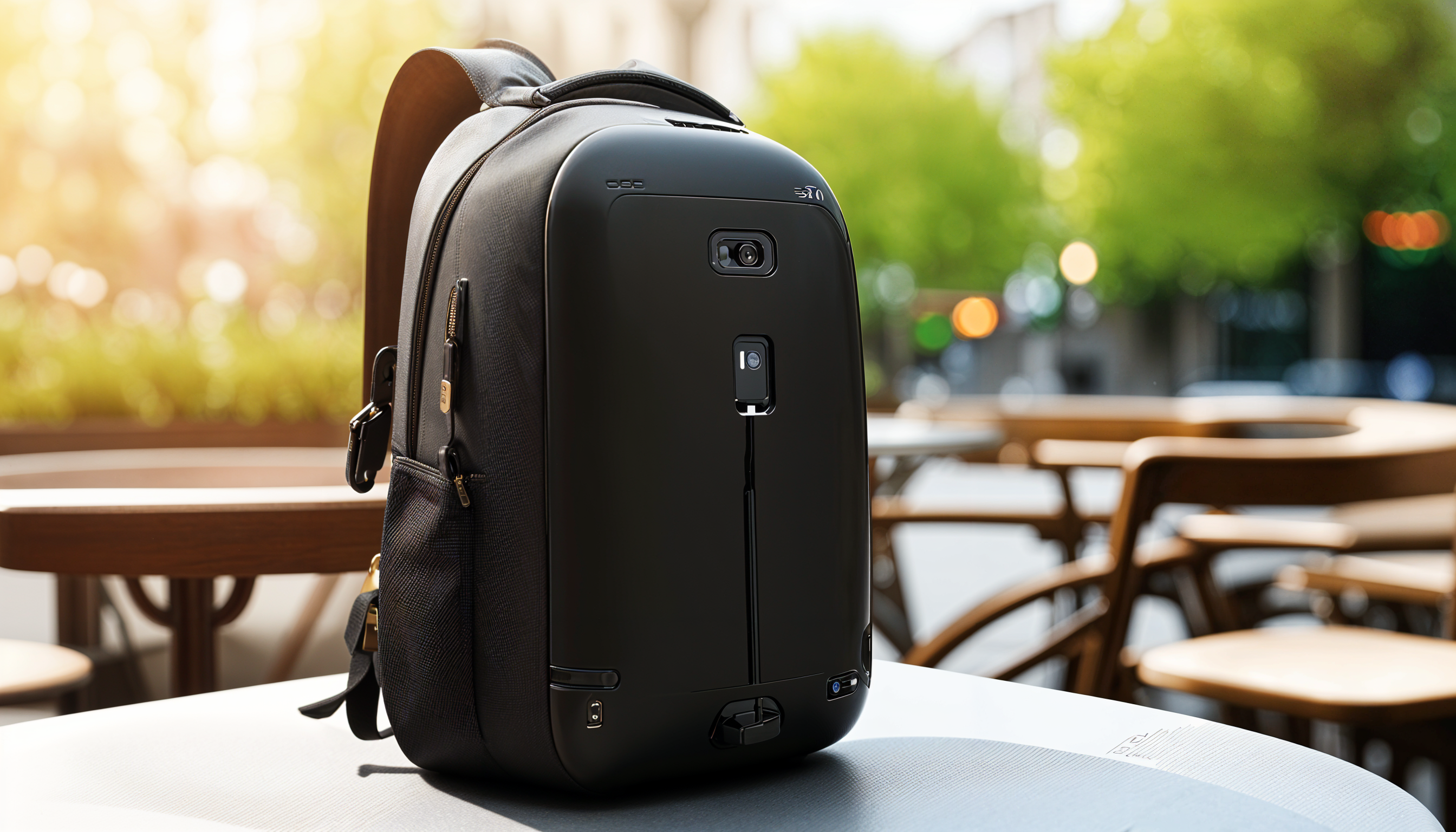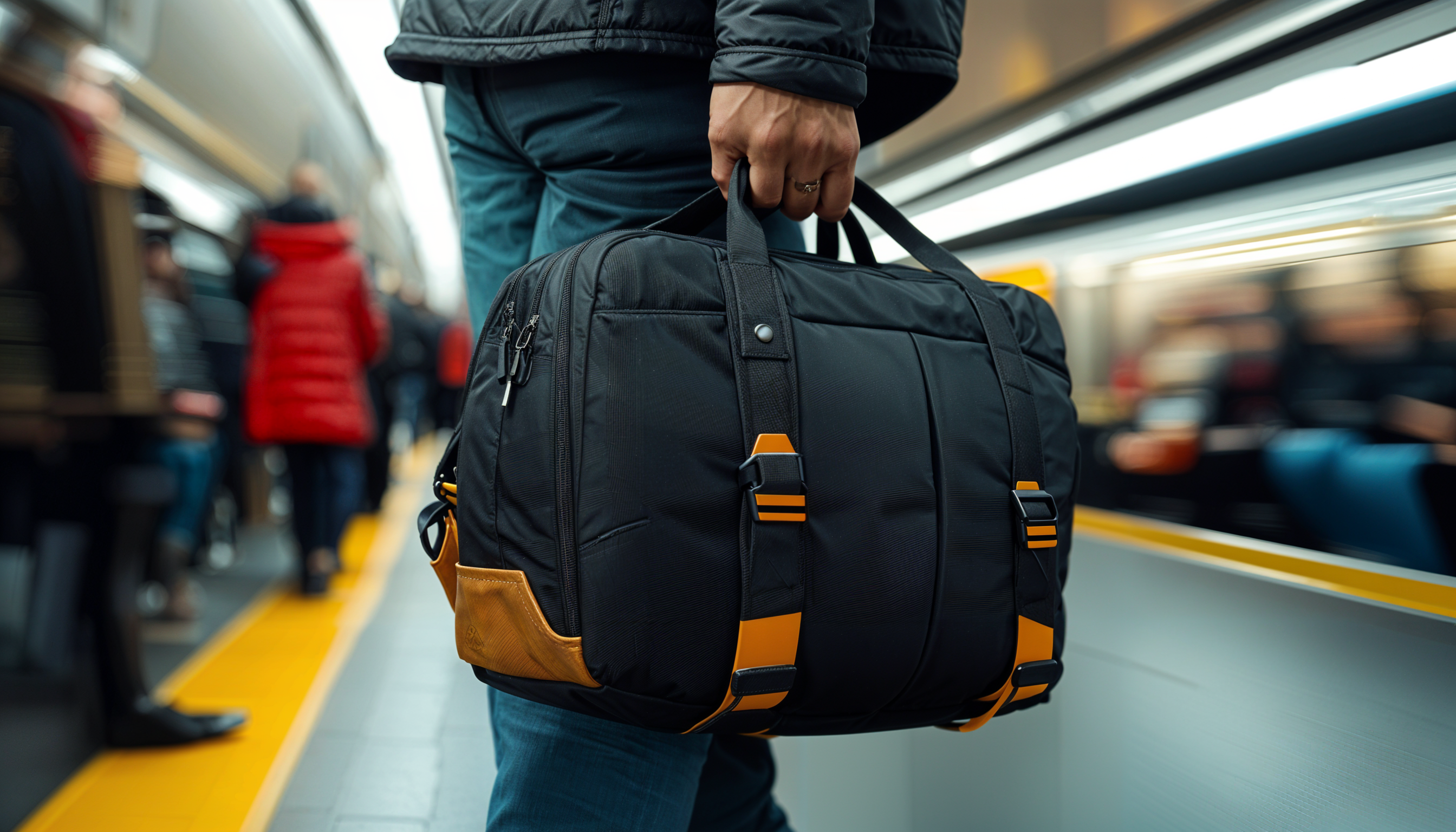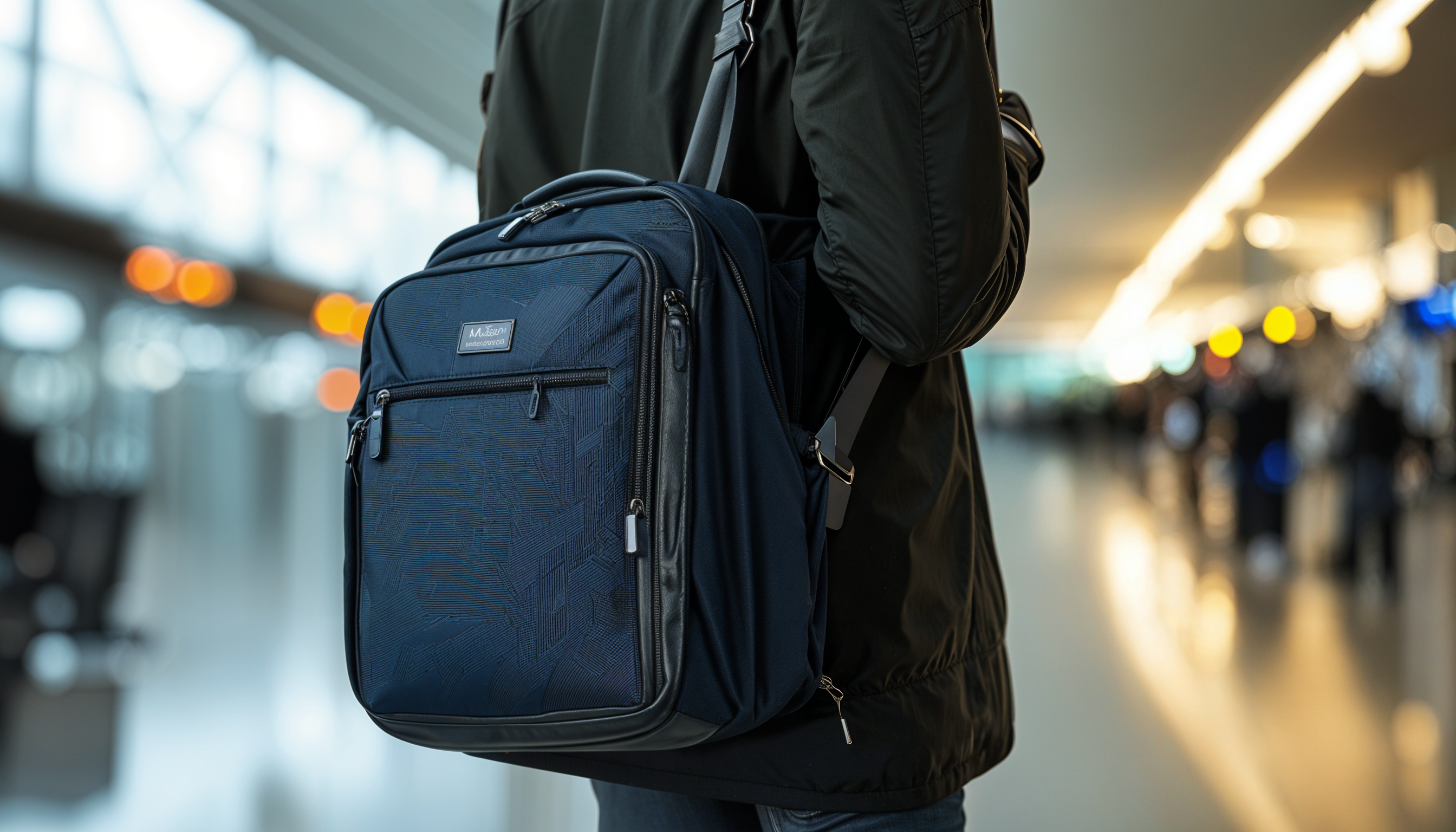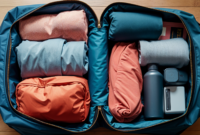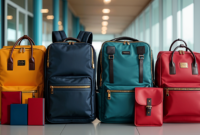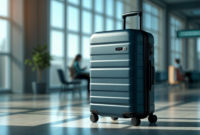Did you know that over 2 million bags are mishandled or stolen globally each year? While travel opens up a world of exciting experiences, it also presents opportunities for theft and loss. From bustling airports and crowded tourist attractions to unfamiliar public transportation, your belongings can be vulnerable in various travel situations. Being vigilant is crucial, but it’s impossible to be on high alert 24/7. That’s where anti-theft travel bags come in, offering a crucial layer of protection for your valuables and peace of mind during your adventures.
Anti-theft travel bags are designed with specific features to deter thieves and safeguard your belongings. These features can range from discreet pockets and hidden compartments to robust locking mechanisms and slash-resistant materials. They not only protect your physical possessions like electronics, cash, and travel documents but also your sensitive personal information, which is increasingly at risk in today’s digital age.
Several innovative technologies are employed in these bags to enhance security. RFID shielding protects your credit cards and passports from electronic data theft, while slash-proof materials and reinforced designs prevent thieves from easily cutting into your bag. Secure locking mechanisms deter opportunistic theft, and tracking devices can help you locate your bag if it’s lost or stolen.
In this article, we’ll delve into the specifics of how these anti-theft technologies work. We’ll explore the mechanisms behind each feature, their effectiveness in deterring theft, and the benefits they offer travelers. Whether you’re a seasoned globetrotter or planning your first international trip, understanding these technologies can help you make informed decisions about choosing the right anti-theft travel bag for your needs and ensuring a safer and more enjoyable travel experience.
Protecting Your Identity: Understanding RFID Shielding Technology
In today’s increasingly digital world, your personal information is more vulnerable than ever, especially when you’re traveling. One technology that has revolutionized various industries but also poses a security risk is Radio-Frequency Identification (RFID). Understanding how RFID works and how it can be exploited is crucial for protecting your identity and financial information while on the go.
What is RFID and How Does It Work?
RFID is a wireless technology that uses radio waves to automatically identify and track tags attached to objects. These tags contain electronically stored information, such as your credit card number, passport details, or driver’s license information. RFID readers emit radio waves that activate the tags, allowing the reader to access the stored data without physical contact. This technology is widely used for tasks like contactless payments, inventory management, and passport control.
The Dark Side of RFID: Potential for Data Theft
While RFID offers convenience, it also presents a security vulnerability. Thieves can use portable RFID readers to scan your RFID-enabled cards or passport from a distance, potentially stealing your sensitive information without you even realizing it. This type of electronic pickpocketing can lead to identity theft, fraudulent transactions, and a host of other problems.
Why RFID Shielding Matters for Travel Bags
Travel bags with built-in RFID shielding offer a crucial layer of protection against this type of data theft. These bags are designed with special materials that block RFID signals, preventing unauthorized access to the information stored on your cards and passport. This is particularly important in crowded areas like airports, train stations, and tourist attractions where you’re more likely to be targeted by thieves.
How Effective is RFID Shielding?
RFID shielding is highly effective in preventing data theft when implemented correctly. The shielding material creates a barrier that disrupts the radio waves used by RFID readers, rendering them unable to access the information on your RFID-enabled items. However, it’s important to note that not all RFID-blocking products are created equal. Look for bags and wallets that have been tested and certified to meet specific RFID-blocking standards.
Travel Bags with Built-in RFID Shielding:
Here are a few examples of travel bags that incorporate RFID-blocking technology:
- Pacsafe Metrosafe LS350 Anti-Theft Backpack: This backpack features an RFIDsafe pocket specifically designed to protect your cards and passport.
- Travelon Anti-Theft Classic Messenger Bag: This messenger bag includes an RFID-blocking card and passport slot to safeguard your valuables.
- XD Design Bobby Urban Anti-Theft Backpack: This backpack has a hidden RFID-protected pocket in the back panel, keeping your sensitive information safe from prying eyes.
Tips for Choosing and Using RFID-Blocking Accessories:
- Look for reputable brands: Choose products from well-known brands that specialize in anti-theft travel gear.
- Check for certification: Look for products that have been tested and certified by independent organizations for RFID-blocking effectiveness.
- Consider the type of shielding: Some products use a thin metallic lining, while others incorporate specialized fabrics with embedded shielding materials.
- Ensure proper coverage: Make sure the RFID-blocking material covers all areas where you store your RFID-enabled items.
Addressing Misconceptions about RFID Blocking:
Some people believe that RFID blocking is unnecessary or that the risk of RFID skimming is exaggerated. However, the reality is that RFID skimming is a real threat, and the technology to carry it out is readily available. While the frequency of RFID skimming incidents may be debated, the potential consequences of having your identity stolen are significant. Investing in RFID-blocking travel accessories provides an extra layer of security and peace of mind, allowing you to focus on enjoying your travels without worrying about the safety of your personal information.
Protecting Your Belongings: Slash-Proof Materials and Designs
Imagine yourself navigating a bustling market or a crowded train station with your travel bag. While you’re focused on the sights and sounds around you, a thief might be eyeing your belongings, looking for an easy opportunity to slash your bag and grab your valuables. This is where slash-proof materials and designs come into play, offering a crucial layer of protection against this type of opportunistic theft.
What are Slash-Proof Materials and How Do They Work?
Slash-proof materials are specifically engineered to resist cuts and tears from sharp objects like knives or box cutters. They typically involve incorporating high-strength fabrics, such as high-density polyester or nylon, or embedding a protective layer within the bag’s construction. One common approach is to use a lightweight steel wire mesh, like Pacsafe’s ExoMesh, which is placed between the outer fabric and the inner lining. This mesh acts as a barrier, preventing thieves from easily slicing through the bag and accessing your belongings.
How Effective are Slash-Proof Bags?
Slash-proof bags are highly effective in deterring “slash-and-grab” theft. The embedded mesh or reinforced fabrics make it significantly more difficult and time-consuming for thieves to cut through the bag, increasing the chances of them being caught or deterred altogether. While no bag is entirely impenetrable, slash-proof designs act as a strong deterrent, making your bag a less appealing target for opportunistic thieves.
Common Slash-Proof Materials:
Several materials are commonly used in slash-proof bags:
- ExoMesh: A lightweight stainless steel wire mesh embedded within the bag’s fabric layers.
- Steel wire mesh: Similar to ExoMesh, but can be heavier and less flexible.
- High-density polyester or nylon: These fabrics are inherently durable and tear-resistant, offering a degree of slash protection even without embedded mesh.
- Cut-resistant fabrics: Specialized fabrics woven with high-performance fibers like polyethylene or P-benzoxazole polyester offer enhanced cut resistance.
Are Slash-Proof Bags Completely Impenetrable?
It’s important to understand that no bag is completely impenetrable. A determined thief with the right tools and enough time could potentially breach even the most robust slash-proof bag. However, the goal of slash-proof designs is to make it significantly more difficult and time-consuming for thieves, deterring them from attempting the theft in the first place.
Examples of Travel Bags with Slash-Proof Construction:
Several brands offer travel bags with slash-proof features. Here are a few examples:
- Pacsafe Metrosafe LS350 Anti-Theft Backpack: Features ExoMesh slashguard technology in key areas.
- Travelon Anti-Theft Classic Messenger Bag: Incorporates slash-resistant straps and panels.
- XD Design Bobby Urban Anti-Theft Backpack: Utilizes hidden zippers and cut-resistant fabric.
Tips for Choosing and Using Slash-Proof Travel Bags:
- Consider your travel style and needs: If you’re traveling to areas known for bag slashing, prioritize bags with comprehensive slash-proof features.
- Look for reputable brands: Choose bags from brands known for their quality and anti-theft technology.
- Check for certifications: Some bags are tested and certified for their slash resistance.
- Inspect the construction: Look for reinforced stitching, durable zippers, and robust materials.
Potential Drawbacks of Slash-Proof Bags:
While slash-proof materials offer enhanced security, they can also introduce some drawbacks:
- Weight: The added mesh or reinforced fabrics can make the bag slightly heavier.
- Flexibility: The embedded mesh might reduce the bag’s overall flexibility.
- Cost: Slash-proof bags tend to be slightly more expensive than standard bags.
Securing Your Bag: Locking Mechanisms and Their Effectiveness
While slash-proof materials and RFID shielding protect your bag’s contents and personal information, robust locking mechanisms are essential to prevent unauthorized access to your belongings in the first place. A good locking system can deter opportunistic thieves and make it significantly harder for them to quickly access your valuables. Let’s explore the different types of locking mechanisms used in travel bags and their effectiveness in keeping your belongings safe.
Types of Locking Mechanisms:
- TSA-Approved Locks: These locks are specifically designed to be opened by the Transportation Security Administration (TSA) during security checks, without damaging your bag or lock. They typically feature a special keyway that allows TSA agents to unlock and inspect your luggage if necessary. TSA-approved locks are crucial for air travel, as they prevent your bag from being forcibly opened if it needs to be inspected.
- Combination Locks: These locks use a set of rotating dials that need to be aligned with a specific combination to unlock. They are relatively easy to use and don’t require carrying a separate key. However, they can be vulnerable to combination guessing or lock picking if the combination is not complex enough.
- Key Locks: These locks use a traditional key to unlock. They are generally considered more secure than combination locks, as they are harder to pick. However, you need to keep track of the key, and losing it can be a major inconvenience.
- Padlocks: These are detachable locks that can be used to secure zippers or other closures on your bag. They come in various sizes and security levels, from basic padlocks to high-security options with hardened shackles and pick-resistant mechanisms.
- Locking Zippers: Some travel bags feature zippers with special locking mechanisms that prevent the zipper pulls from being easily separated. These can be a quick and convenient way to deter opportunistic theft, but they may not be as secure as a dedicated padlock.
Effectiveness of Locking Mechanisms:
The effectiveness of a locking mechanism depends on several factors, including the type of lock, its quality, and how it’s used. TSA-approved locks are essential for air travel, but they may not offer the highest level of security against determined thieves. Combination locks are convenient but can be vulnerable to guessing or picking. Key locks are generally more secure but require careful key management. Padlocks offer a wide range of security levels, and choosing a high-quality padlock can significantly enhance your bag’s security. Locking zippers offer a basic level of protection but may not be sufficient for high-risk situations.
Examples of Travel Bags with Robust Locking Mechanisms:
Many travel bag brands incorporate robust locking mechanisms into their designs. Here are a few examples:
- Pacsafe Venturesafe EXP45 Anti-Theft Carry-On Travel Pack: Features the Roobar™ V locking system, which allows you to secure multiple compartments with a single padlock.
- Osprey Farpoint 40 Travel Backpack: Includes lockable zippers on the main compartment and a dedicated laptop sleeve.
- Travelon Anti-Theft Classic Messenger Bag: Features a slash-resistant strap and locking zippers on the main compartment.
Tips for Choosing and Using Travel Bag Locks Effectively:
- Choose TSA-approved locks for air travel: This ensures your bag can be inspected without being damaged.
- Opt for high-quality padlocks with hardened shackles and pick-resistant mechanisms: These offer better protection against determined thieves.
- Use multiple locking points: Secure multiple compartments or zippers with separate locks to make it harder for thieves to access your belongings.
- Consider locking zippers in addition to padlocks: This adds an extra layer of security, especially for opportunistic theft.
- Don’t use easily guessable combinations: Avoid using birthdays or other obvious combinations for your combination locks.
- Keep your keys secure: If you’re using key locks, keep your keys in a safe place and separate from your bag.
Addressing Potential Vulnerabilities:
While locking mechanisms enhance security, they are not foolproof. Here are some potential vulnerabilities and ways to mitigate them:
- Lock Picking: Some locks can be picked by skilled thieves. Choose high-quality locks with pick-resistant mechanisms to reduce this risk.
- Weak Zipper Pulls: Some bags have weak zipper pulls that can be easily broken or forced open. Look for bags with durable zipper pulls or consider using a padlock to secure the zippers.
- Lost Keys: Losing your keys can render your key lock useless. Consider using a combination lock or keeping a spare key in a safe place.
By understanding the different types of locking mechanisms, their strengths and weaknesses, and potential vulnerabilities, you can make informed decisions about how to best secure your travel bag and protect your belongings during your travels.
Securing Your Bag to Stationary Objects: Locking Cables and Anchor Straps
Even with slash-proof materials and locking zippers, your bag can still be vulnerable to theft if someone simply grabs the entire bag and runs. To prevent this, consider using locking cables or anchor straps to secure your bag to a stationary object. This adds another layer of security, making it much harder for thieves to make off with your belongings.
Locking Cables: Your Bag’s Best Friend at the Cafe
The simplest way to understand a locking cable is to think of it like a bike lock for your bag. It’s essentially a flexible steel cable that you can loop around a secure object, like a table leg or a railing, and then secure with a padlock. This prevents anyone from simply walking off with your bag while you’re distracted. Locking cables are particularly useful in cafes, restaurants, or on public transport where you might need to leave your bag unattended for a short period.
When choosing a locking cable, consider its length and thickness. A longer cable provides more flexibility in terms of what you can secure your bag to, while a thicker cable offers greater resistance to cutting. Some travel bags, like the Pacsafe Venturesafe EXP45, even come with built-in locking cables for added convenience.
Anchor Straps: Versatility and Peace of Mind
Another option for securing your bag is an anchor strap. These straps are typically integrated into the bag’s design and can be used to tether your bag to a fixed object. Some anchor straps are simply reinforced loops that you can thread a padlock through, while others have built-in locking mechanisms. For example, the Pacsafe Vibe 25L Anti-Theft Backpack features a PopNLock security clip built into one of the straps, allowing you to quickly secure your bag to a chair or post.
Anchor straps offer versatility, as you can use them to secure your bag in various situations, from leaving it on the beach while you swim to attaching it to a luggage rack on a train. They can also provide peace of mind when you’re in crowded areas or unfamiliar environments.
Tips for Effective Use:
- Choose a sturdy object: Make sure the object you’re securing your bag to is strong and immobile. A flimsy chair or a wobbly railing won’t offer much protection.
- Loop the cable or strap through multiple points: If possible, loop the cable or strap through multiple handles or attachment points on your bag for added security.
- Use a high-quality padlock: A cheap padlock can be easily picked or broken. Invest in a sturdy padlock with a hardened shackle and pick-resistant mechanism.
- Be mindful of your surroundings: Even with a secured bag, it’s important to be aware of your surroundings and take precautions against potential theft.
Limitations and Alternatives:
While locking cables and anchor straps can be effective deterrents, they’re not foolproof. A determined thief with the right tools could potentially cut through a cable or break a padlock. Additionally, these methods might not be practical in all situations, such as when there are no suitable objects to secure your bag to.
In such cases, consider using alternative security measures, such as luggage trackers. These small devices can be placed inside your bag and tracked via GPS or Bluetooth, allowing you to locate your bag if it’s lost or stolen.
By combining multiple anti-theft measures, such as slash-proof materials, locking mechanisms, and securing your bag to stationary objects, you can significantly enhance the security of your belongings and enjoy your travels with greater peace of mind.
Tracking Your Bag: GPS Technology and Smart Luggage Tags
In today’s interconnected world, technology offers a powerful tool to keep track of your belongings, even when they’re out of sight. GPS tracking devices and smart luggage tags have emerged as valuable additions to the arsenal of anti-theft features in travel bags, providing peace of mind and increasing the chances of recovering lost or stolen luggage.
GPS Tracking Devices: Your Luggage’s Digital Guardian
GPS (Global Positioning System) tracking devices are small, battery-powered gadgets that use satellite signals to determine their location. When placed inside your travel bag, these devices can pinpoint your luggage’s whereabouts in real-time, allowing you to track its movements through a smartphone app or a web interface. Some advanced GPS trackers even offer features like geofencing, which sends you alerts if your bag leaves a designated area, and proximity alerts, which notify you if your bag is nearby.
Effectiveness of GPS Trackers in Luggage Recovery
The effectiveness of GPS trackers in recovering lost or stolen luggage can vary depending on several factors, including the tracker’s signal strength, battery life, and the availability of cellular or Wi-Fi networks in the area where the bag is located. However, numerous success stories demonstrate their value in reuniting travelers with their belongings. For instance, Samsonite International, a leading luggage manufacturer, collaborated with Google to launch Track&Go, a device that aids in tracking and locating luggage (Samsonite International, n.d.).
Features to Look for in a Travel Bag GPS Tracker
When choosing a GPS tracker for your travel bag, consider the following features:
- Battery Life: Opt for a tracker with a long battery life, ideally lasting for several days or even weeks on a single charge.
- Tracking Range: Ensure the tracker has a wide tracking range, especially if you’re traveling internationally.
- Accuracy: Look for a tracker with high accuracy to pinpoint your bag’s location precisely.
- Subscription Costs: Some GPS trackers require a monthly or annual subscription for data services. Factor these costs into your decision.
- Geofencing and Proximity Alerts: These features can provide an extra layer of security and convenience.
- Durability and Water Resistance: Choose a tracker that can withstand the rigors of travel, including bumps, drops, and potential exposure to moisture.
Examples of Travel Bags with Integrated GPS Tracking:
Several travel bag brands are now incorporating GPS tracking technology directly into their designs. Here are a few examples:
- Samsonite Track&Go Connected Luggage: Features a built-in GPS tracker that allows you to track your bag’s location via a smartphone app.
- Away Carry-On: Offers an optional ejectable battery with a built-in GPS tracker that complies with airline regulations.
- Arlo Skye The Frame Carry-On Max: Includes a removable battery with a built-in GPS tracker and a proximity sensor.
Privacy and Data Security Considerations
While GPS trackers offer valuable security benefits, it’s essential to be mindful of privacy and data security implications. Ensure the tracker you choose uses secure data transmission protocols and that the app or web interface you use to access your bag’s location data is protected by strong passwords and encryption.
Cost of GPS Tracking Devices and Subscription Services
The cost of GPS tracking devices can range from around $30 to over $100, depending on the features and brand. Some trackers also require a monthly or annual subscription for data services, which can add to the overall cost.
Alternatives to GPS Trackers: Bluetooth Trackers and Smart Luggage Tags
If you’re looking for a more budget-friendly alternative to GPS trackers, consider Bluetooth trackers or smart luggage tags. Bluetooth trackers, like Tile or Apple AirTags, use Bluetooth technology to connect to your smartphone and can help you locate your bag within a limited range. Smart luggage tags, like LugLoc or Dynotag, use a combination of Bluetooth and crowd-sourced GPS technology to track your bag’s location. While these alternatives may not offer the same level of accuracy and range as dedicated GPS trackers, they can still be helpful in preventing loss and aiding in recovery.
The Bottom Line: Choosing the Right Anti-Theft Travel Bag for Your Needs
Throughout this article, we’ve explored a range of anti-theft technologies designed to safeguard your belongings and personal information during your travels. From RFID shielding and slash-proof materials to robust locking mechanisms and GPS tracking, these features offer varying levels of protection against different types of theft. Now, let’s bring it all together and discuss how to choose the right anti-theft travel bag for your specific needs.
Factors to Consider
When selecting an anti-theft travel bag, several factors come into play:
- Your Travel Style: Are you a frequent traveler, a backpacker, or an occasional vacationer? Your travel style will influence the type of bag you need, its size, and the level of security features you prioritize. For instance, a backpacker might prioritize slash-proof materials and locking cables, while a business traveler might focus on RFID shielding and a sleek, professional design.
- Your Budget: Anti-theft bags come in a wide range of prices, depending on the brand, features, and materials used. Set a realistic budget and look for bags that offer the best value for your money.
- Your Destination and Perceived Risk: Are you traveling to a high-risk area known for theft or a relatively safe destination? Your destination’s security environment should influence your choice of anti-theft features.
- The Value of Your Belongings: If you’re carrying expensive electronics, valuable jewelry, or sensitive documents, you’ll want to invest in a bag with robust security features.
- Your Personal Preferences: Consider your preferred bag style, size, and comfort level. Anti-theft features shouldn’t compromise the bag’s functionality or your overall travel experience.
The Power of Combining Anti-Theft Measures
For comprehensive protection, consider combining multiple anti-theft measures. A bag with slash-proof material and locking zippers might deter opportunistic thieves, but adding a locking cable or anchor strap can further secure your bag in public spaces. Similarly, RFID shielding can be combined with hidden pockets and secure compartments to safeguard your valuables and personal information.
Prioritize Your Travel Security
Investing in a travel bag with appropriate anti-theft features is a proactive step towards ensuring a safer and more enjoyable travel experience. By prioritizing your travel security, you can minimize the risk of theft and focus on creating lasting memories.
The Future of Anti-Theft Technology
The landscape of travel security is constantly evolving, with new technologies and innovative designs emerging to address the challenges of theft and loss. As technology advances, we can expect to see even more sophisticated anti-theft features integrated into travel bags, offering travelers greater peace of mind and protection for their belongings.

